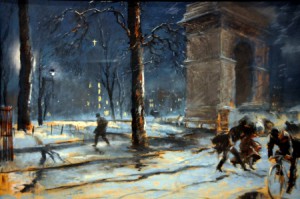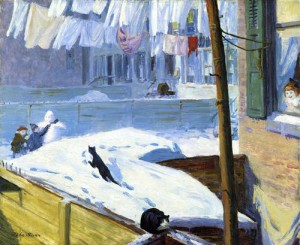Art in the Village: The Ashcan School

The Ashcan School refers to a loosely knit group of urban realist painters based in New York City during the early 20th century. Founded by artist and teacher Robert Henri in Philadelphia around 1891, the movement attracted a gathering of newspaper illustrators including George Luks, John Sloan, William Glackens*, and Everett Shinn.
Artists of the Ashcan School composed paintings in a loose and spontaneous style, one very different from the polished techniques taught in the American art academies of the period (think American Impressionism – realism and structure, vivid colors and bright light, portraits and tranquil interiors). Ashcan painters’ slap-dash rapid handling of paint, obvious brushstrokes, thick application, and dark subdued palettes characterized their innovative style, reminiscent of the journalistic qualities many of them possessed.
This new artistic movement was rooted in the raw, visceral, daily life of city dwellers. Ashcan painters focused on scenes of the Lower East Side and the Bowery including those of newly arrived immigrants, dockworkers, nightclub performers, saloon keepers, boxers, and the average worker trying to make ends meet while squeezing whatever small pleasure there was to be had out of life. The artists sought new forms of realism to describe the rapid and great changes in urban life, commercial culture, and codes of social contact.
Below are a few classic Ashcan School paintings set in and around the Village. Many of the buildings depicted in these cityscapes have been preserved through landmarking.

Watching the three [women] from his studio at Sixth Avenue and West Fourth Street, Sloan called them unselfconscious performers in “another of the human comedies which were regularly staged for my enjoyment by the humble roof-top players of Cornelia Street,” according to this caption from the Metropolitan Museum of Art.




[Everett Shinn] painted tenement fires, bread lines, and theater scenes, but he especially liked to depict the parks and squares of the city; Washington Square, a 13.5 acre park in the midst of New York City’s Greenwich Village, was his favorite,” states the website for the Museum of Fine Arts in Boston, which owns [the painting above].

*Click to watch the video and view photos from our past program with art historian Avis Berman to learn more about William Glackens.

One response to “Art in the Village: The Ashcan School”